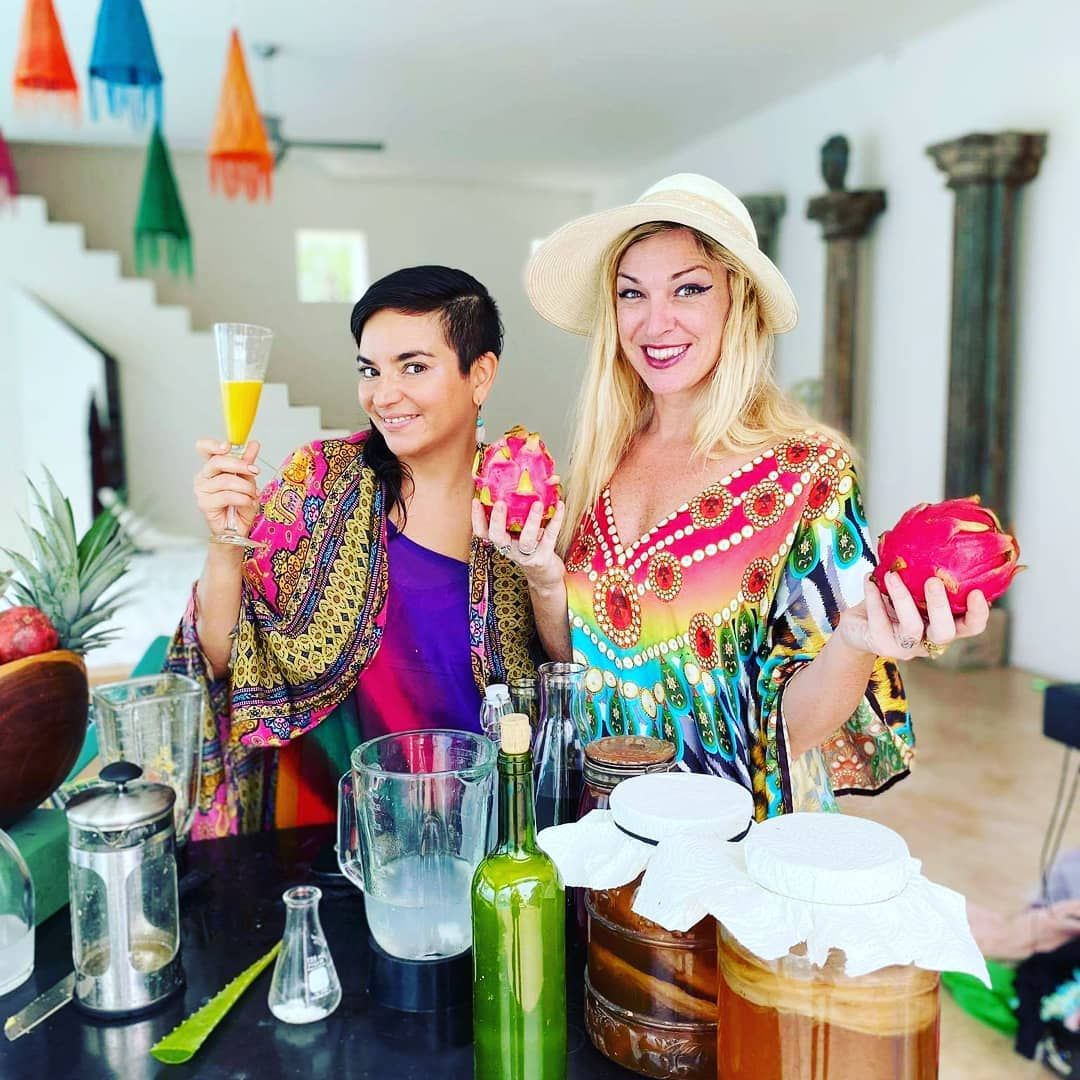Welcome To Our Plant Directory
These are all of the plants that we currently are tending to in our food forest. We listen to these plants and they provide us with food and medicine. Please consider donating to our project for building a regenerative community in Costa Rica that will further educate people on how to have reciprocal and sustainable relationships with plants.
Alba Bidens,
Bidens alba
Anti-inflammatory, wound healing, immune support, supports pollinators.
Bidens alba has been traditionally used in folk medicine across the Americas to treat skin wounds, soothe inflammation, and boost immune function. The leaves are often made into poultices or brewed as tea to support internal healing. Rich in antioxidants and minerals, this resilient plant is also a valuable pioneer species, helping to stabilize soil and restore degraded land. Its abundant flowers are highly attractive to bees, butterflies, and other pollinators, making it an important ally for ecosystem health.
Avocado,
Persea americana
Heart healthy, nutrient-dense, supports skin and hormone balance.
Persea americana has been cultivated for thousands of years across Mesoamerica for both food and medicine. The creamy fruit is rich in monounsaturated fats, fiber, potassium, and B vitamins, supporting cardiovascular health, glowing skin, and hormone regulation. Florida varieties tend to be larger and less oily than Hass, but equally nourishing. Traditionally, the leaves have been brewed into teas to ease bloating and respiratory issues, while the seed is sometimes ground for its antioxidant properties.
Baby's Breath, Gypsophila paniculata
Supports respiratory health, anti-inflammatory, antioxidant.
Baby's Breath, traditionally used in European and Asian cultures, is known for its gentle beauty and is often included in herbal remedies to support respiratory health and reduce inflammation.
Basil, Ocimum basilicum
Antibacterial, supports digestion, anti-inflammatory.
Basil has been traditionally used in Ayurvedic and Mediterranean medicine to support digestion, ease respiratory issues, and reduce inflammation. Rich in essential oils and antioxidants, basil helps protect the body from infections and oxidative stress. It is commonly enjoyed fresh in foods or brewed into teas for its healing and revitalizing effects.
Blanket Flower, Gaillardia pulchella
Antioxidant, skin-soothing, supports inflammation balance.
Known for its vibrant red and yellow petals, Gaillardia pulchella has been used in Native American traditions as a tea for treating skin conditions and minor wounds. Though more widely appreciated as an ornamental wildflower, it also offers light medicinal qualities, especially in soothing irritated tissue and reducing mild inflammation. Blanket flower is drought-tolerant, pollinator-friendly, and often used in permaculture to attract beneficial insects.
Broadleaf Chaya, Cnidoscolus aconitifolius
Protein-rich, anti-inflammatory, supports blood sugar balance.
Broadleaf chaya has long been used in traditional Mesoamerican medicine and cuisine as a powerful leafy green for boosting strength and resilience. It is easy to identify by its large, broad, more rounded leaves compared to the butterfly type. Once cooked to remove natural toxins, the leaves are used to support blood sugar regulation, reduce inflammation, and provide abundant nutrients. This variety is prized for its high leaf production and easy cultivation in hot climates.
Bull’s Eye Spilanthes, Acmella oleracea
Analgesic, immune-stimulating, antifungal.
Often called the “toothache plant,” Acmella oleracea has been traditionally used to relieve oral pain, fight infection, and boost immune function. Chewing the flower creates a tingling, numbing sensation, which is how it got its reputation in folk herbalism. The leaves and flowers can be made into tinctures or teas, and its striking bullseye blooms also attract pollinators to the garden.
Butterfly Chaya, Cnidoscolus aconitifolius
Nutrient-dense, anti-inflammatory, blood sugar support.
Traditionally used in Central American and Mexican herbal medicine, Cnidoscolus aconitifolius is highly valued as a superfood and tonic herb. The butterfly variety can be recognized by its deeply lobed, delicate leaves that resemble butterfly wings. Once properly cooked, the leaves are used to strengthen the immune system, reduce inflammation, and support balanced blood sugar. Its striking shape and ability to attract pollinators make it both a healing food and a garden favorite.
Cardamom, Elettaria cardamomum
Digestive aid, breath freshener, antioxidant.
Traditionally used in both Ayurvedic and traditional Chinese medicine. It is known for its digestive properties, helping with indigestion, nausea, and heartburn. Cardamom is also used as a natural breath freshener and is believed to have aphrodisiac properties.
Chives, Allium schoenoprasum
Supports digestion, antioxidant, antimicrobial.
Chives are traditionally used in European and Asian cuisine for their mild onion flavor, but they also have medicinal properties. The plant is believed to support digestion, reduce inflammation, and improve circulation.
Clitoria, Clitoria ternatea
Memory enhancer, anti-stress, skin care.
In Ayurvedic and traditional Asian medicine, Clitoria is used to enhance cognitive function, reduce stress, and promote relaxation. The plant’s vibrant blue flowers are often used in various cultural rituals and to make tea, which is believed to support skin health and combat premature aging. Clitoria is also known for its antioxidant properties, which help protect the body from oxidative stress.
Coconut, Cocos nucifera
Hydration, supports digestion, anti-inflammatory.
Coconut has been used in tropical regions for centuries for its hydrating properties. The oil extracted from the fruit is used in cooking, skin care, and as a natural remedy for various ailments. Coconut water is rich in electrolytes and is commonly used to rehydrate the body.
Cranberry Hibiscus, Hibiscus acetosella
Rich in antioxidants, supports cardiovascular health, anti-inflammatory.
Cranberry hibiscus has been traditionally used in African and Caribbean cultures to support cardiovascular health, improve digestion, and boost vitality. Its vibrant, antioxidant-rich leaves are often eaten raw in salads or brewed into teas. The plant is valued for its ability to strengthen the immune system and reduce inflammation naturally.
Cucumber Weed, Commelina diffusa
Cooling, mildly diuretic, anti-inflammatory.
Cucumber weed has been traditionally used in tropical and subtropical regions as a gentle remedy to cool the body and support urinary health. Its succulent, trailing stems and small blue flowers make it easy to identify in moist, shady areas. The tender leaves are edible and have a mild cucumber-like taste when fresh. Used in salads or lightly steamed, the plant offers hydration, light detox support, and is valued as a forager’s friend in hot climates.
Edible Cactus, Opuntia spp.
Anti-inflammatory, supports digestion, blood sugar regulation.
Edible Cactus, particularly Nopal, is traditionally used in Mexican and Central American medicine to treat diabetes, digestive issues, and inflammation. The pads are eaten fresh or cooked to support overall health.
Eliance Escarole,
Cichorium endivia
Bitter tonic, digestive support, rich in folate.
A slightly bitter leafy green from the chicory family, Cichorium endivia has been traditionally used to stimulate digestion, cleanse the liver, and regulate appetite. Eliance escarole produces broad, tender leaves with a creamy heart and a gentle bite. It’s often braised, added to soups, or eaten raw in moderation to encourage bile flow and nutrient absorption.
Epazote, Dysphania ambrosioides
Antiparasitic, supports digestion, respiratory health.
Epazote is traditionally used in Mexican and Central American medicine as a digestive aid and to expel intestinal parasites. The plant is also believed to have anti-inflammatory properties and is often added to beans and other legumes to reduce gas.
French Green Sorrel,
Rumex acetosa
Digestive stimulant, high in vitamin C, mildly cleansing.
This classic European sorrel is known for its lemony, tangy flavor and tender green leaves. Traditionally used in spring tonics and soups, Rumex acetosa supports digestion, gently stimulates the liver, and delivers a natural boost of vitamin C. Its sour taste is due to oxalic acid, which gives it a cleansing effect when eaten raw or lightly cooked in moderation.
Ginger, Zingiber officinale
Anti-inflammatory, digestive aid, nausea relief.
Ginger has a long history of use in traditional medicine, particularly in Asia, where it is used to treat digestive issues, nausea, and inflammation. It is also popular as a natural remedy for colds and flu. The root is often used fresh, dried, or powdered in cooking and herbal remedies.
Golden Berry, Physalis peruviana
Rich in vitamins, supports immune health, antioxidant.
Golden Berry, also known as Physalis, is traditionally used in South American folk medicine to support immune health and combat infections. The fruit is rich in antioxidants and vitamins, particularly vitamin C, which supports overall health.
Ice Cream Banana, Musa acuminata
Rich in potassium, supports heart health, aids digestion.
The Ice Cream Banana, known for its creamy texture and vanilla-like flavor, is a popular fruit in tropical regions. It is rich in potassium and other essential nutrients, making it a healthy snack. Traditionally, the leaves and fruit have been used to aid digestion and provide energy.
Jewels of Opar, Talinum paniculatum
Antioxidant, supports wound healing, anti-inflammatory.
Jewels of Opar is traditionally used in herbal medicine for its cooling and soothing properties. The plant is believed to support skin health, reduce inflammation, and improve overall vitality.
Katuk, Sauropus Androgynus
Rich in protein, supports immune health, anti-inflammatory.
Katuk, also known as Sweetleaf, is traditionally used in Southeast Asian medicine as a nutritional supplement. The leaves are rich in vitamins and minerals and are believed to support lactation in nursing mothers.
Krishna Basil, Ocimum Tenuiflorum
Antioxidant, supports immune health, anti-inflammatory.
Krishna Basil, a variety of Holy Basil, is traditionally used in Ayurvedic medicine to support respiratory health, reduce stress, and improve overall vitality. The plant is also believed to have strong antioxidant and anti-inflammatory properties.
Lemongrass, Cymbopogon citratus
Digestive aid, antimicrobial, calming.
Lemongrass has long been used in Southeast Asian and Ayurvedic medicine to soothe digestion, reduce fevers, and calm the nervous system. Its tall, fragrant blades are brewed into teas or used fresh in cooking, offering citrusy essential oils with antimicrobial and stress-relieving properties. Often grown in herb gardens and food forests, Cymbopogon citratus is easy to propagate and doubles as a natural mosquito repellent in tropical landscapes.
Longevity Spinach, Gynura procumbens
Anti-inflammatory, supports cardiovascular health, antioxidant.
Longevity Spinach is traditionally used in Southeast Asian medicine as a tonic to promote overall health and longevity. It is rich in antioxidants and is believed to support cardiovascular health, improve circulation, and reduce inflammation.
Malabar Spinach, Basella alba
Rich in vitamins, supports digestion, antioxidant.
Malabar Spinach is traditionally used in Southeast Asian cuisine and medicine for its nutritional benefits. The leaves are rich in vitamins and minerals and are believed to support digestion, improve skin health, and boost immunity.
Mango,
Mangifera indica
Rich in antioxidants, supports digestion, boosts immune function, promotes skin health, and helps regulate blood sugar.
Mango has been traditionally used in Ayurvedic and tropical medicine to aid digestion, boost immunity, and promote healthy skin. High in vitamins A and C, as well as powerful polyphenols, mango helps the body combat oxidative stress and inflammation. The fruit is eaten fresh, dried, or juiced, while the leaves have been used in herbal preparations to balance blood sugar and support respiratory health.
Hibiscus Acetosella
Ornamental Edible Hibiscus, Hibiscus acetosella or hybrid cultivar
Anti-inflammatory, rich in antioxidants, supports skin and blood health.
This unique variety of hibiscus is not only stunning in appearance, with its multicolored and deeply veined leaves, but also highly medicinal and edible. Traditionally used in African and Caribbean folk medicine, the young leaves are eaten raw or cooked for their tangy, sorrel-like flavor and are known to support blood purification and skin vitality. The leaves contain beneficial anthocyanins and polyphenols that help reduce inflammation and oxidative stress. With its eye-catching foliage, edible value, and resilience in warm climates, it’s a nourishing and beautiful ally in the garden..
Meyers Lemon, Citrus ×
Rich in vitamin C, supports immune health, antioxidant.
Meyers Lemon, a hybrid citrus fruit, is traditionally used for its high vitamin C content and digestive benefits. The fruit is commonly used to make lemonade, teas, and in various culinary dishes, providing a refreshing and nutritious addition to any meal.
Monstera,
Monstera deliciosa
Anti-inflammatory, antioxidant, mild digestive support.
Traditionally found in Central American rainforests, Monstera deliciosa is best known for its dramatic, fenestrated leaves and its rare, pineapple-banana-flavored fruit. While primarily ornamental, the ripe fruit has been used in folk medicine for its mild digestive and anti-inflammatory properties. The plant thrives in tropical shade and climbs readily, making it a beautiful companion in lush gardens. Only the fully ripe fruit is edible—unripe parts and foliage contain oxalates and should be avoided.
Moringa, Moringa
Rich in nutrients, supports immune health, antioxidant.
Moringa, also known as the Drumstick Tree, is a highly nutritious plant used in traditional medicine to treat malnutrition, support immune health, and reduce inflammation. The leaves, seeds, and pods are all edible and are rich in vitamins, minerals, and antioxidants.
Mother of Thousands,
Kalanchoe pinnata
Wound healing, anti-inflammatory, antimicrobial.
Traditionally used in African, Caribbean, and Ayurvedic medicine, Kalanchoe pinnata is known for its ability to accelerate wound healing and reduce inflammation. The fleshy leaves are often crushed and applied topically to cuts, burns, and insect bites. Internally, teas made from the leaves have been used to support respiratory health and ease urinary tract discomfort. This resilient succulent also propagates easily from leaf margins, symbolizing regeneration and vitality in many healing traditions.
Mugwort, Artemisia
Supports digestion, anti-inflammatory, anxiety relief.
Mugwort has a long history in traditional European and Chinese medicine. It is commonly used to stimulate digestion, regulate menstruation, and treat anxiety. The plant is also used in moxibustion, a traditional Chinese medicine practice that involves burning mugwort on specific points of the body to stimulate healing.
Mulberry, Morus nigra
Antioxidant-rich, supports blood health, anti-inflammatory.
Traditionally used in Eastern and Mediterranean herbal medicine, Morus nigra is prized for its sweet, dark berries and nutrient-dense leaves. The fruit is rich in iron, vitamin C, and anthocyanins, supporting healthy blood, immune function, and cellular repair. The leaves are sometimes brewed into teas to regulate blood sugar and reduce inflammation. This fast-growing tree offers abundant seasonal fruit and attracts pollinators, birds, and foragers alike with its generous, edible gifts.
Oregano, Origanum
Antibacterial, supports respiratory health, antioxidant.
Oregano has been used in traditional medicine for centuries to treat respiratory issues, digestive problems, and infections. The herb is rich in antioxidants and has strong antibacterial and antifungal properties.
Ornamental Hibiscus, Hibiscus rosa-sinensis
Antioxidant, supports skin health, anti-inflammatory.
Ornamental Hibiscus, while primarily grown for its beautiful flowers, also has medicinal properties. In traditional medicine, hibiscus is used to support cardiovascular health, reduce blood pressure, and improve skin health.
Papaya, Carica papaya
Digestive aid, supports skin health, anti-inflammatory.
Papaya is traditionally used in tropical medicine for its digestive enzymes, particularly papain, which aids in digestion. The fruit is also applied topically for skin healing and is believed to have anti-inflammatory properties that support overall health.
Passion Fruit, Passiflora edulis
Anxiolytic, sedative, anti-inflammatory.
Passion fruit has been traditionally used in South American and tropical folk medicine to calm the nerves, support digestion, and promote restful sleep. Rich in antioxidants, vitamins, and fiber, it helps boost the immune system and support heart health. The fruit is often eaten fresh or made into juices and teas for its soothing and revitalizing effects.
Pineapples, Ananas Comosus
Rich in vitamins, supports digestion, anti-inflammatory.
Pineapple is traditionally used in tropical medicine for its digestive enzymes, particularly bromelain, which aids in digestion and reduces inflammation. The fruit is also valued for its high vitamin C content and its ability to support immune health.
Porter Weed, Stachytarpheta
Antioxidant, anti-inflammatory, supports immune health.
Porter Weed has been used in traditional Caribbean medicine to treat colds, flu, and respiratory issues. The leaves and flowers are often made into teas or poultices to reduce inflammation and relieve pain.
Purple Holy Basil or Krishna Tulsi, Ocimum tenuiflorum
Adaptogenic, antimicrobial, supports respiratory and mental clarity.
Highly revered in Ayurvedic medicine, Ocimum tenuiflorum is known as a sacred plant used to restore balance and vitality. The Krishna variety is recognized by its purple stems, darker leaves, and deep clove-like aroma. Traditionally, it has been used to support lung health, clear the mind, and strengthen the immune system. Often brewed as tea or used in herbal rituals, Krishna Tulsi is considered a rasayana — a rejuvenating tonic that supports long-term resilience and spiritual well-being.
Red Batavia Lettuce,
Lactuca sativa
Hydrating, antioxidant-rich, supports liver and digestion.
Red Batavia is a crisp, mildly sweet lettuce prized for its wavy, bronze-tinged leaves and excellent heat tolerance. Traditionally, lettuces like Lactuca sativa have been used in herbal diets to gently cleanse the liver and cool the body. The red pigmentation adds extra antioxidants, while its high water content aids digestion and hydration. This variety is especially appreciated in warmer climates where other lettuces bolt quickly.
Red Veined Sorrel,
Rumex sanguineus
Antioxidant, liver support, blood-cleansing.
Recognized by its striking red veins and tangy bite, Rumex sanguineus has been traditionally used as a blood purifier and tonic herb. Like other sorrels, it aids digestion and stimulates detox pathways, but its anthocyanin-rich coloring offers added antioxidant protection. It adds a beautiful pop of color to salads and regenerative gardens alike.
Roselle, Hibiscus Sabdariffa
Antioxidant, supports cardiovascular health, diuretic.
Roselle is traditionally used to make beverages, teas, and jams. It is known for its high vitamin C content, which supports immune health. The plant has also been used to regulate blood pressure, reduce inflammation, and improve digestion.
Roselle is traditionally used to make beverages, teas, and jams. It is known for its high vitamin C content, which supports immune health. The plant has also been used to regulate blood pressure, reduce inflammation, and improve digestion.
Shiso, Perilla
Anti-inflammatory, supports respiratory health, antioxidant.
Shiso, also known as Perilla, is traditionally used in Japanese and Korean cuisine, as well as in traditional medicine. The plant is believed to support respiratory health, reduce inflammation, and improve digestion.
Spanish Albahaca, Ocimum basilicum
Antibacterial, supports respiratory health, anti-inflammatory.
Spanish Albahaca, or Basil, is commonly used in traditional medicine for its antibacterial and anti-inflammatory properties. It is often used to treat respiratory ailments, digestive issues, and to promote overall health and wellness.
Stone Breaker Plant, Phyllanthus niruri
Supports kidney health, anti-inflammatory, detoxifying.
Stone Breaker, or Chanca Piedra, is traditionally used in South American medicine to treat kidney stones and gallstones. The plant is also believed to have diuretic properties, supporting kidney health and detoxification.
Sun Hemp, Crotalaria juncea
Soil improver, nitrogen fixer, supports soil fertility.
Sun Hemp is traditionally used as a cover crop to improve soil fertility and prevent erosion. The plant is also believed to have medicinal properties, including the ability to support digestive health and reduce inflammation.
Sunchokes, Helianthus tuberosus
Supports digestion, prebiotic, aids in blood sugar regulation.
Sunchokes, also known as Jerusalem artichokes, have been traditionally used by Native American tribes and early settlers to support digestion and nourish the body. Rich in inulin, a prebiotic fiber, they promote gut health and help regulate blood sugar. Sunchokes are often eaten roasted or raw, offering a natural way to boost energy, improve digestion, and support overall vitality.
Surinam Cherry, Eugenia uniflora
Antioxidant, supports digestion, fever reduction.
Traditionally used in South American and Caribbean medicine, Eugenia uniflora is valued for its astringent, cleansing qualities and high antioxidant content. The bright red or deep purple, ribbed fruits are eaten fresh or made into jams and syrups, while the leaves are brewed into teas to help reduce fever and promote digestive health. This hardy shrub also makes an excellent living fence and is beloved by pollinators and birds alike. Its glossy leaves and pumpkin-shaped fruit make it easy to identify in the landscape.
Sweet Potatoes, Ipomoea batatas
Rich in nutrients, supports blood sugar regulation, anti-inflammatory.
Sweet Potatoes are traditionally used in many cultures as a staple food, but they also have medicinal properties. The root is rich in vitamins and antioxidants, supporting immune health, digestion, and skin health.
Toilet Paper Plant, Verbascum thapsus
Soothes irritated skin, anti-inflammatory, respiratory support.
The Toilet Paper Plant, also known as Mullein, is traditionally used to treat respiratory issues such as coughs, colds, and bronchitis. The soft leaves are also used as a natural alternative to toilet paper, especially in survival situations.
Tropical Lemon Balm, Melissa officinalis
Calming, supports digestion, antiviral.
Tropical Lemon Balm is traditionally used in herbal medicine to treat anxiety, insomnia, and digestive issues. The plant is also believed to have antiviral properties and is often used to support respiratory health.
Turmeric, Curcuma
Anti-inflammatory, supports joint health, antioxidant.
Turmeric has been used for centuries in Ayurvedic and traditional medicine to reduce inflammation, support digestion, and promote joint health. Its active compound, curcumin, is a strong antioxidant that helps protect the body from oxidative stress. Traditionally, turmeric is consumed in teas, meals, or applied as a paste to aid healing and relieve pain.
Variegated Oregano, Origanum vulgare variegata
Antibacterial, supports respiratory health, antioxidant.
Variegated Oregano shares many of the same medicinal properties as traditional oregano, including its use in treating respiratory and digestive issues. The plant is also valued for its ornamental appeal in gardens.
Variegated Peppermint,
Mentha × piperita
Cooling, antimicrobial, digestive aid.
This eye-catching peppermint features creamy variegated leaves and the classic menthol scent. Used for centuries to soothe the stomach, relieve headaches, and cool inflammation, Mentha × piperita is a garden staple in herbal traditions worldwide. It makes a refreshing tea, is excellent in skin preparations, and thrives in containers or damp garden edges.
Velvet Bean, Mucuna pruriens
L-DOPA content, improves mood, antioxidant.
Velvet Bean, also known as Mucuna pruriens, has been used traditionally in Ayurvedic medicine as a natural source of L-DOPA, a precursor to dopamine. It is known for its ability to improve mood, support mental clarity, and enhance libido. The beans are also believed to have neuroprotective properties, supporting overall brain health.
Vicks Plant, Plectranthus amboinicus
Antibacterial, supports respiratory health, anti-inflammatory.
The Vicks Plant, known for its menthol-like aroma, is used in traditional medicine to treat respiratory issues such as colds, coughs, and congestion. The leaves can be crushed and inhaled to clear nasal passages or applied topically to relieve muscle pain.






